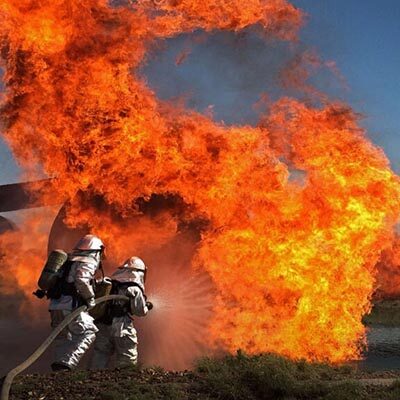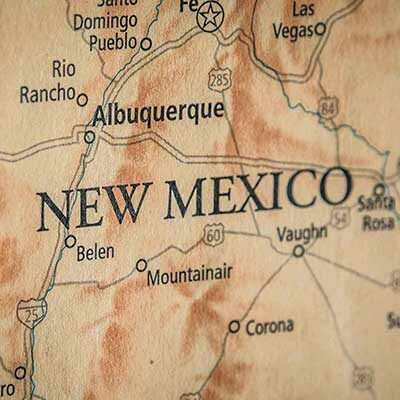Questions remain about PFAS pollution from Holloman
Laura Paskus
December 1, 2020
This fall, we asked to meet with experts at Holloman Air Force Base about water contamination from PFAS, or per- and polyfluoroalkyl substances.
In seeking to talk with base officials, we were particularly interested in learning more about a few key issues, including:
- How the groundwater contamination has moved since testing was completed in late 2017, and where the PFAS plume is predicted to move in the coming years,
- What outreach the Air Force has done to help military personnel and families, as well as residents, understand the contamination and the risks to exposure from PFAS,
- Whether military firefighters who used aqueous film forming foam have been tested for PFAS exposure, and
- What the timeline is for the cleanup of PFAS pollution at Holloman Air Force Base.
These aren’t necessarily new questions. But they remain largely unanswered.
In November 2018, the Air Force notified the New Mexico Environment Department that tests conducted in late 2017 showed the presence of toxic PFAS in surface and ground water. The PFAS came from the use of aqueous film forming foam—foam used to extinguish fires and train firefighters. And that PFAS, in turn, made its way into soils, groundwater, and surface waters like Lake Holloman, which is fed by wastewater from the base.
PFAS samples at Holloman were as high as 1,294,000 parts per trillion. The human health advisory—for a lifetime drinking water exposure to PFAS—is 70 parts per trillion.
The state of New Mexico issued a notice against the military for violating the state’s Water Quality Act, and the U.S. Department of Defense sued New Mexico, challenging the state’s authority. In turn, the state filed another lawsuit, asking a federal judge to compel the military to clean up PFAS plumes below Holloman and also Cannon Air Force Base. At the time, the state was seeking quick action. But the case was moved to multi-district litigation and a court in South Carolina which is overseeing all cases regarding PFAS and the military’s use of aqueous film forming foam—more than 750 separate cases. To speed up action, the state requested to pull itself out from that multi-district litigation. But in September, the judge denied that request.
At Holloman, the military has reiterated that drinking water supplies have not been contaminated. But the state of New Mexico still wants the pollution contained and cleaned. In 2019, NMED Secretary James Kenney pointed out that state regulations “don’t distinguish between water that’s usable for drinking today, and water that’s usable for drinking tomorrow.”
And it’s not only water. The November 2018 report also lists other ways people might have been or could be exposed to PFAS.
According to the report, for example, contact with contaminated sediment can affect “on-base personnel, grounds maintenance workers, utility workers, construction workers, site visitors, trespassers and/or recreational users of Lake Holloman,” as well as people engaged in maintenance or recreational activities at Apache Mesa Golf Course.
Holloman Lake is fed by wastewater from the base, but its adjoining wetland has become an important stopover for migrating birds and until recently was open to the public as a camping spot and recreational area.
In short, it’s a complicated situation and we have a lot of questions. We hoped to find more answers and help people better understand what’s happening and what the future holds.
But Holloman personnel would not meet with us in person, nor be interviewed via Zoom.
Throughout the course of our reporting—and despite pending lawsuits—state officials have joined us for interviews, and provided additional information about contamination. But Holloman officials told NMPBS that “[d]ue to ongoing litigation, personnel will not be conducting interviews.”
We asked for clarification, and received this emailed answer: “Whenever there is ongoing litigation we are limited to what information we can provide to the public or media. By submitting your inquiry in writing, it allows us to have our responses reviewed and approved by a number of subject matter experts from different units at Holloman and at a higher level. We also vet our responses through our Legal team and by our Wing Commander.”
Below, we have pasted the answers to our emailed questions.
Q1. What is the known extent of the contamination and its predicted spread?
A1. The Air Force is planning additional efforts consistent with the Comprehensive Environmental Response, Compensation, and Liability Act of 1980 (CERCLA) process to define the nature and extent of PFOS/PFOA impact at Holloman. These future efforts will help determine nature and extent of the contamination, and inform any needed remedial actions.
Currently, the USAF is prioritizing response actions to PFOS/PFOA contamination based on impacts to drinking water sources. At this time, PFOS/PFOA at Holloman is not threatening drinking water sources. There are no drinking water sources down gradient from the five sites that tested above the drinking water Health Advisory Level.
Q2. What has been the Air Force's outreach to the community about the contamination and its cleanup?
A2. At Holloman, base leadership met with community stakeholders and adjacent land owners in December 2018 and January 2019 to discuss the results of the 2018 Site Investigation report.
Q3. What is the timeline for cleanup?
A3. Contamination of drinking water sources is a driving factor for cleanup requirements. Since PFOS/PFOA was only found in groundwater and does not affect Holloman’s drinking water supply, which comes from wells 12-35 miles southeast of the base, a timeline for cleanup is unknown at this time.
Q4. What is the potential exposure of military personnel, contractors, and families to the contamination via water on base, etc.
A4. The presence of PFOS/PFOA in groundwater underneath Holloman AFB does not impact drinking water sources at the base or the surrounding community. Drinking water for Holloman AFB comes from well fields located 12 to 35 miles southeast of the installation. These wells have been and continue to be tested and are free of PFOS/PFOA contamination.
Q5. What are the steps taken to identify military personnel who were directly exposed to the firefighting foams and determine if they were adversely affected by exposures?
A5. As directed by section 707 of the Fiscal Year 2020 National Defense Authorization Act, PFAS blood testing for DoD firefighters was made available during an individual's annual occupational medical examination beginning on October 1, 2020. While the blood test is available and offered to every firefighter as part of their annual occupational medical exam, the testing is not mandatory. A DoD-approved fact sheet is provided to every firefighter at the time of the blood testing and they are given the option to decline the test, or if tested, to view the results of their PFAS blood testing. All individual test results are retained in each firefighter's medical record. That information is protected medical information under the Health Insurance Portability and Accountability Act and is not publicly releasable.
Q6. Can I have the current maps that show the plume's delineation?
A6. All data collected during the Preliminary Assessment and Site Investigation are accessible to the public on the Air Force’s administrative record. The intent of the SI was to determine presence and absence of constituents. The nature and extent of the impact is determined though the Remedial Investigation process.
Q7. Has there been testing since the original site assessment in 2017, to show how/where the contamination is moving?
A7. Because the presence of PFOS/PFOA in groundwater at Holloman AFB has not impacted drinking water sources, no additional testing has occurred.
Q8. How has the Air Force mitigated potential human exposure to PFOS and PFOA via soil contamination, as outlined in the 2018 site investigation report?
A8. The five areas identified with PFOS/PFOA have very limited access. The sewage lagoon site is completely fenced. The golf course area closed operations in April 2020 for financial reasons. The Evaporation Pond 2 is located in a highly controlled access area of the flight line operations. The fire training area is located in a remote area of the base and the current operations are conducted inside a fenced facility with limited access. The access gates to the Holloman Evaporation pond are closed.
If you’ve been affected by PFAS contamination in your community here in New Mexico, call our tip line at (505) 433-7242. To read more coverage of PFAS in New Mexico visit “Groundwater War: New Mexico’s Toxic Threat,” which includes a timeline of events and studies on PFAS.






